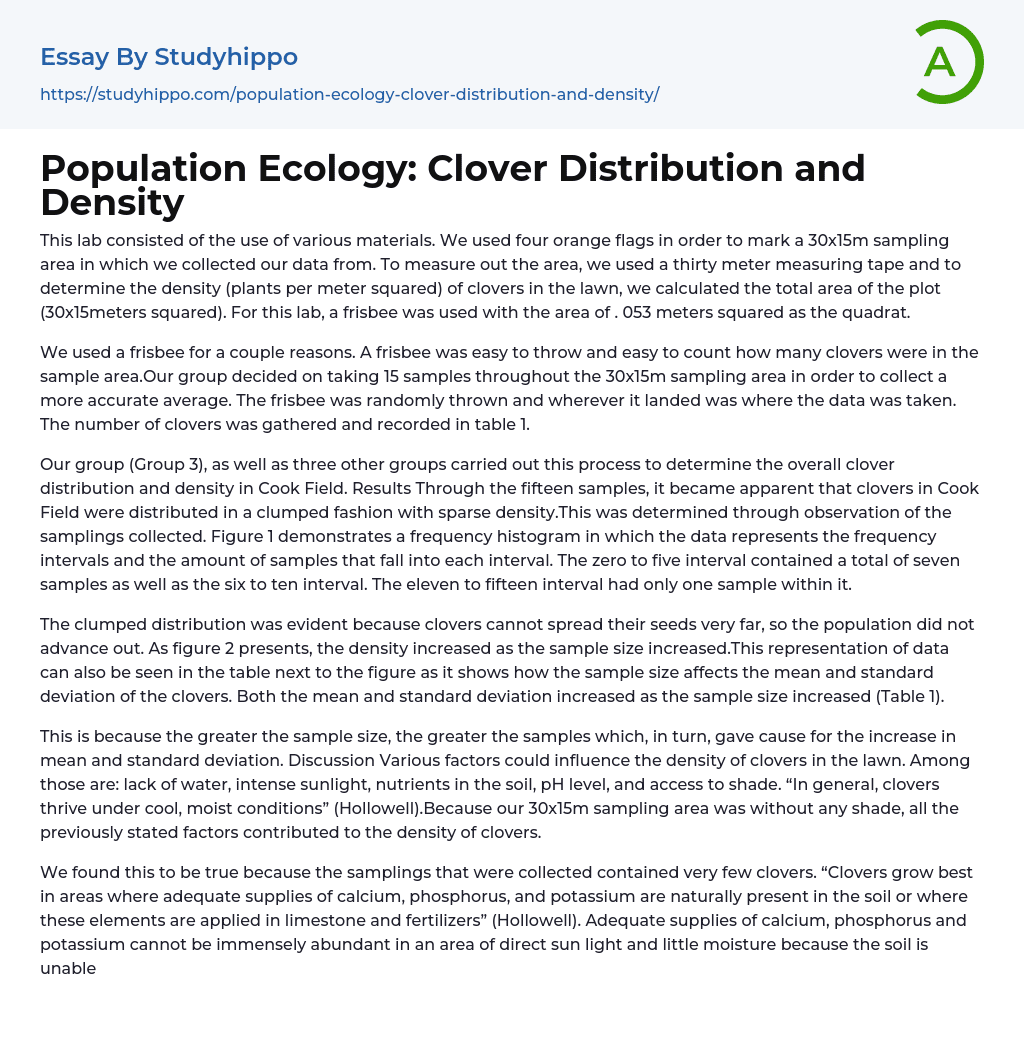

Population Ecology: Clover Distribution and Density Essay Example
This lab consisted of the use of various materials. We used four orange flags in order to mark a 30x15m sampling area in which we collected our data from. To measure out the area, we used a thirty meter measuring tape and to determine the density (plants per meter squared) of clovers in the lawn, we calculated the total area of the plot (30x15meters squared). For this lab, a frisbee was used with the area of . 053 meters squared as the quadrat.
We used a frisbee for a couple reasons. A frisbee was easy to throw and easy to count how many clovers were in the sample area.Our group decided on taking 15 samples throughout the 30x15m sampling area in order to collect a more accurate average. The frisbee was randomly thrown and wherever it landed was where the data was taken. The number of clo
...vers was gathered and recorded in table 1.
Our group (Group 3), as well as three other groups carried out this process to determine the overall clover distribution and density in Cook Field. Results Through the fifteen samples, it became apparent that clovers in Cook Field were distributed in a clumped fashion with sparse density.This was determined through observation of the samplings collected. Figure 1 demonstrates a frequency histogram in which the data represents the frequency intervals and the amount of samples that fall into each interval. The zero to five interval contained a total of seven samples as well as the six to ten interval. The eleven to fifteen interval had only one sample within it.
The clumped distribution was evident because clovers cannot spread their seeds ver
far, so the population did not advance out. As figure 2 presents, the density increased as the sample size increased.This representation of data can also be seen in the table next to the figure as it shows how the sample size affects the mean and standard deviation of the clovers. Both the mean and standard deviation increased as the sample size increased (Table 1).
This is because the greater the sample size, the greater the samples which, in turn, gave cause for the increase in mean and standard deviation. Discussion Various factors could influence the density of clovers in the lawn. Among those are: lack of water, intense sunlight, nutrients in the soil, pH level, and access to shade. “In general, clovers thrive under cool, moist conditions” (Hollowell).Because our 30x15m sampling area was without any shade, all the previously stated factors contributed to the density of clovers.
We found this to be true because the samplings that were collected contained very few clovers. “Clovers grow best in areas where adequate supplies of calcium, phosphorus, and potassium are naturally present in the soil or where these elements are applied in limestone and fertilizers” (Hollowell). Adequate supplies of calcium, phosphorus and potassium cannot be immensely abundant in an area of direct sun light and little moisture because the soil is unable to contain the nutrients.This is another reason as to why there was such a small density in the area that was measured.
The distribution of the clover population in Cook Field was defined as clumped. “Plants are often clumped where soil conditions and other environmental factors favor germination and growth” (Campbell). This proved to be true
in a sense that we found the clovers to all be fairly sparse in the field because there were poor soil conditions due to various environmental factors.However, when we did collect larger samples of clovers, we saw that the clover density was larger with larger sample sizes. The area in which we took our data had a major role in possible sources of error.
Because we observed the clover density in an area of little or no shade, it was difficult to compare to the rest of the field’s plants population density measured. To better this experiment, we could have taken data from an area of part shade, part sun. By doing so, the various environmental factors would be more evident as to it affects the clover density and dispersion.Population ecology is defined as “the study of populations in relation to the environment, including environmental influences on population density and distribution, and variations in population size” (Campbell). This lab directly relates to population ecology because it focused on the clover population and it’s relation to Cook Field. The lab took into account the various environmental factors such as sunlight, nutrient level, and moisture content.
Through the collected data, the population density and distribution of the clovers was determined.
- Atom essays
- Big Bang Theory essays
- Density essays
- Electricity essays
- Energy essays
- Force essays
- Heat essays
- Light essays
- Motion essays
- Nuclear Power essays
- Physiology essays
- Sound essays
- Speed essays
- Temperature essays
- Thermodynamics essays
- Mean essays
- Atmosphere essays
- Biodiversity essays
- Coral Reef essays
- Desert essays
- Earth essays
- Ecosystem essays
- Forest essays
- Lake essays
- Natural Environment essays
- Ocean essays
- Oxygen essays
- Rainbow essays
- Sea essays
- Soil essays
- Volcano essays
- Water essays
- Wind essays
- Cultural Assimilation essays
- Demography essays
- Ethnographic essays
- Population essays
- Population Growth essays



